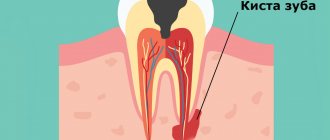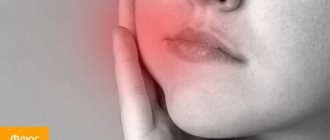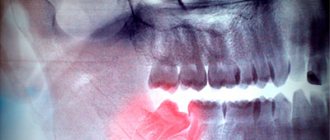Author of the article:
Soldatova Lyudmila Nikolaevna
Candidate of Medical Sciences, Professor of the Department of Clinical Dentistry of the St. Petersburg Medical and Social Institute, Chief Physician of the Alfa-Dent Dental Clinic, St. Petersburg
Expecting relief from pain from going to the dentist, patients sometimes leave the office confused - why hasn’t the pain completely gone away? It can be present for several hours or last much longer.
Why does a tooth hurt after filling?
The filling that the doctor places on the treated tooth should exclude the possibility of disease. If you feel pain after filling, the reason may be:
- The body's natural reaction to outside interference. Even after proper treatment, such a phenomenon may occur, which is periodic in nature. The pain in this case does not increase or become too severe; it can last from 2 weeks to 2 months.
- Caries is not completely cured. The tooth tissues become inflamed, and the tooth hurts after filling with aching pain. In this case, it is necessary to contact the dentist again to prevent further complications - inflammation can affect the dental nerve (pulpitis develops).
- Chronic or developing pulpitis that was not identified during the diagnostic process before the start of treatment.
- Incomplete treatment of tissues affected by inflammation during periodontitis. Treatment of periodontitis is not limited to one day, it is quite complex.
- If the filling is installed incorrectly (either at an insufficient level, or is large and puts pressure on other teeth or gums). Often a tooth hurts after root canal filling for this very reason. Damage to the filling can occur due to insufficiently high quality filling material or failure to comply with the recommendations of the dentist.
- Slight pain may be felt due to tissue injury during the process of tooth filling. It will take some time for healing to occur.
- The sensitivity of teeth after filling always increases significantly, and discomfort, manifested in painful sensations, can be the result of insufficiently correct implementation of one of the treatment procedures - drying the inner dental walls (over-drying or under-drying). If the walls of the tooth are not completely dry when installing the filling, it does not adhere well in damp places, which leads to the development of inflammation and pain.
- Allergic reaction to the filling material.
It is much easier to identify pathologies after dental treatment if all the dentist’s advice and oral hygiene rules are followed.
Attention! Dentists recommend that their patients have a small snack before going to the dental office, so that due to the lack of glucose that occurs during treatment, fear and the vasoconstrictive effect of the drugs, they do not experience a semi-fainting state during the treatment.
How long after filling should I abstain from eating?
Modern fillings contain epoxy resin, which ensures that the new filling quickly hardens into the desired shape. Light-polymer fillings harden almost instantly, while those made from chemical materials take no more than an hour. Therefore, after filling a tooth, you can eat food immediately.
When installing a temporary filling, a longer period of time abstaining from eating is required - at least 2 hours.
Pain after tooth extraction
After the tooth is removed and the anesthesia wears off, the patient may experience minor pain, which usually goes away quickly. However, sometimes 1-3 days after surgery a sharp pain appears in the area of the socket of the extracted tooth .
Taking analgesics does not bring relief. This pain most often occurs due to disruption of the normal healing process of the tooth socket. In addition, the pain may be caused by the remaining sharp edges of the socket or by an exposed area of the alveolar bone not covered with soft tissue.
My gums hurt after filling a tooth, what should I do?
If, after installing a filling, your gums are very sore and even your cheek is swollen, you cannot do without the help of a dentist. Moreover, it is necessary to contact as soon as possible so that there are no even more unpleasant consequences.
A few tips to relieve pain:
- applying an ice compress to the cheek at the sore spot for several minutes or a compress with ice cubes;
- alternate application of compresses with warm rinses from decoctions of medicinal herbs or infusions;
- painkillers;
- balms to strengthen teeth and gums.
Attention! Under no circumstances should you apply hot or warm compresses - they actively provoke inflammation and pain!
Taking antibiotics without a doctor's prescription is also extremely contraindicated, because this can lead to a decrease in immunity and complicate further treatment.
Preventive measures
After filling a tooth, during the first week, you must strictly follow the main rules so that pain does not occur, or it disappears as soon as possible:
- do not drink or eat too cold or too hot, as temperature changes provoke pain;
- every time after eating, brush your teeth and rinse your mouth with special anesthetic rinses (the ASEPTA series includes rinses with an analgesic and disinfecting effect);
- try to eat softer foods so as not to damage the periodontal tissues, and it is preferable to chew only on the healthy side;
- do not smoke, as the tooth disturbed by treatment is very sensitive in the first days.
Memo for patients
- Do not delay visiting your doctor if there are signs of an allergic reaction.
- If the pain increases, swelling, redness, or fever appears, make an emergency appointment
- Do not relieve pain with antibiotics unless prescribed by a doctor.
- Do not use alcohol or garlic applications, as they can burn the mucous membrane.
- Never heat your tooth
- Follow all dentist recommendations
A qualified doctor, a clinic with modern digital equipment and following the recommendations will help you avoid situations where a tooth hurts after installing a filling.
Expert of the article Bolshakova Evgenia Vladimirovna Dentist-hygienist
More than 11 years of experience
Experts' opinion
The effectiveness of the ASEPTA series products has been proven by multiple clinical trials conducted in the country's leading research institutes.
For example, a study of the clinical effectiveness of treatment and prophylactic agents from the Asepta line in the treatment of inflammatory periodontal diseases, conducted by A.I. Grudyanov, I.Yu. Alexandrovskaya, V.Yu. Korzunina in the Department of Periodontology of the Central Research Institute of Dentistry and Maxillofacial Surgery of Rosmedtekhnologii, Moscow, made it possible to identify the fairly high effectiveness of the Asepta gum balm and the Asepta mouth rinse for moderate periodontitis. The use of Asepta mouth rinse for inflammation also turned out to be quite effective. In addition, no phenomena of mucosal irritation or brown staining of fillings were recorded. This indicates that the use of this rinse for a two-week period provides an obvious clinical effect in the absence of negative side effects.
Pain after pulpitis treatment
When treating pulpitis, the nerve is removed and the canals are cleaned. This is a complex procedure during which special instruments are inserted into the root canals, which can injure tissue near the apex of the root. When treating canals, powerful antiseptics are used, which sometimes irritate nearby tissues. Therefore, after the end of anesthesia, patients almost always feel pain of varying intensity.
When the canal filling procedure is carried out correctly, the pain goes away within 1-7 days, gradually subsiding until it disappears completely.
Consumer Reviews
Mrs. Doubtfire about Asepta Active mouth rinse (irecommend.ru):
“When I was faced with a serious gum problem, this rinse was recommended to me by a dental surgeon.
Asepta Active mouthwash is a medical product and is sold only through the pharmacy chain. The instructions recommend taking breaks in use. Personally, I use it in courses and during exacerbations of gum inflammation. I've been using it for about 2 years.
The mouthwash is minty, pleasant, slightly astringent. Improvement is felt from the first use. Bottle volume 150 ml. Manufacturer: Russia, St. Petersburg. A convenient measuring cup is included.
You can (better) buy it as a set, which also includes balm and toothpaste, which comes as a gift.
I’m very happy that such products from a domestic manufacturer have appeared!”
julia-06 about Asepta Active mouth rinse (irecommend.ru):
“A very good rinse for problem gums.
She had never encountered the problem of bleeding gums, but at her next visit to the dentist she noticed that when she only lightly touched her gums, they began to bleed. So the dentist gave me a mini version of Paradontax toothpaste and advised me to use a mouthwash after brushing my teeth. Mom bought Asepta active mouth rinse.
For some reason I used to be very skeptical about such remedies, but as it turned out, in practice it helps very well. My problem went away completely, my gums stopped bleeding. I don’t even want to read the ingredients and go into its details, it’s unlikely that everything is super natural, but since it helps, I give the mouthwash a solid 5 points. Of course, each case is individual, but I will recommend it based on my experience. And the price of the rinse aid is quite reasonable.”
Pain after periodontitis treatment
The peculiarity of periodontitis is that it often develops asymptomatically, so the tooth may not bother you before treatment, and only after a visit to the dentist begins to hurt. The doctor is not at fault here; the pain that arises is explained by the complexity of the pathological process.
With periodontitis, pathogenic microorganisms move freely from the oral cavity to the root of the tooth, gradually accumulating in the bone tissue around it. After treatment, when the canals are filled, access to the tooth root for bacteria is blocked, the source of infection is localized, and the bacteria remaining in the bone tissue are neutralized by the body’s immune system. If the course of the disease is favorable, pain disappears within two months after treatment.
With weak immunity or other individual characteristics of the body, an inflammatory process occurs. Patients feel aching pain, throbbing, pain when biting and pressing on the tooth. If you experience complaints after periodontitis treatment, you should immediately see a doctor, as additional treatment may be needed.
How can you relieve toothache after treatment?
After dental treatment, you need to follow these recommendations:
- Do not drink drinks that are too hot or cold, and food should also be at medium temperature.
- At first, do not chew with a filled tooth.
- Until the pain disappears, eat soft food or grind it so that a hard piece does not accidentally fall on the treated tooth.
- For increasing pain, you can take anti-inflammatory drugs: ibuprofen (Nurofen, MIG 400), ketorolac (Ketanov), nimesulide (Nimesil, Affida Fort).
- If the gums are inflamed, rinse your mouth with a warm infusion of chamomile, a soda-salt solution (one teaspoon of table salt and baking soda per glass of water).
- If threatening symptoms occur, you should consult a doctor.
How to speed up the healing process of the hole?
The process of tissue regeneration will be as comfortable and painless as possible if you follow the following instructions:
- do not injure the blood clot;
- do not eat for 3-6 hours after tooth extraction;
- exclude hard, spicy, sweet and hot foods from the diet for several days;
- avoid physical exertion, hypothermia and overheating for 3 days after removal;
- use a toothbrush with softer bristles;
- give up smoking and alcohol for a couple of days;
- Follow your dentist’s recommendations for taking anti-inflammatory and pain medications.
A tooth hurts under a filling when pressed: reasons
The main reasons why a tooth under a filling may hurt when pressed:
- Medical error. The canals were treated poorly during dental surgery or the filling does not completely cover the damaged enamel.
- Lack of hygiene. Neglect or poor brushing of teeth after eating, chewing hard foods with teeth with fresh fillings.
- Worn filling. On average, the protective properties of a filling last for 5 years. Then the protection begins to weaken and needs to be replaced.
- Error during filling. The material of modern fillings contains a significant amount of chemical elements. And such a composition can cause an allergic reaction in the patient. It manifests itself gradually, first of all, the feeling of discomfort intensifies, aching pain occurs, and the inflammatory process begins.
- Pulpitis develops under the filling. The long process of caries development leads to the development of inflammation. In this case, pain occurs constantly. The disease progresses quickly and can lead to tooth loss, so you should not hesitate to visit the dental clinic.
- Apical periodontitis. The inflammatory process develops due to the lack of timely treatment. Pain occurs when pressing on the tooth.










